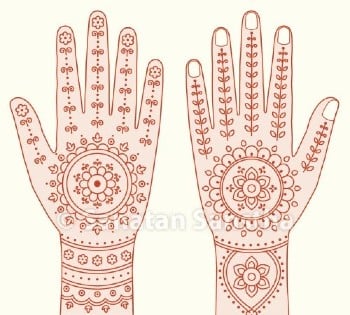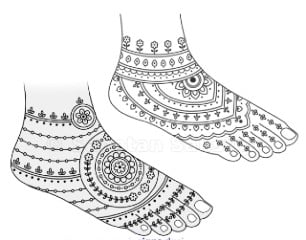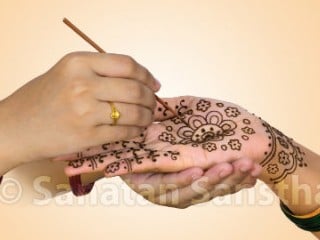
Women like to draw mehendi designs on their hands and feet on festivals and auspicious occasions or even as a pastime. Mehendi is drawn on hands and feet using readymade cones available in the market, using patterns from books or from past experience. Today getting mehendi drawn from commercial artists, before weddings, has become a trend. However this is done only for cosmetic reasons and as entertainment. For mehendi artists it is a source of income. However, the importance attributed to drawing mehendi is even greater. For thousands of years mehendi which is an inseparable part of Hindu culture, has been benefiting women by attracting sattvik vibrations and frequencies of Deities through the designs.
Art is a tool leading an individual to God-realisation. Performing art as spiritual practice is doing it in a sattvik manner as per expectations of God, and further going closer to the God Principle. Even mehendi art which appears simple can be used as a medium for God-realisation if done as spiritual practice.
1. History of mehendi art in Bharat
1 A. Tretayug
At the marriage ceremonies of Shrirama, Lakshman, Bharat and Shatrughna in the Tretayug their hands, feet and faces were embellished with stone colours (colours made from different coloured stones) and pushparang (colours made from different flowers) in floral and leafy designs, as part of the makeup. As different Divine medicinal plant juices were mixed with these colours this fragrant mixture was called ‘patravali’. (Reference : Bhushundi Ramayan and Shrinathmuni Ramayan’)
1 B. Dwaparyug
In the Dwaparyug too ‘patravali’ was used in makeup. Shrikrushna’s companion named Tok would embellish Shrikrushna with ‘patravali’. This is mentioned in the main Holy texts on Shrikrushna, the Gargasanhita, Shrimadbhagwat, Shrikrushnakarnamrut etc. In those days even Shrikrushna’s cows would be embellished with ‘patravali’.
1 C. Kaliyug
1 C 1. The hidden period
‘It is a misconception that Muslims brought the custom of applying mehendi to Bharat. In reality, in the hidden period before the arrival of Muslims into Bharat this practice of application of mehendi existed.’ (Reference : Bharatiya Sanskrutikosh, Vol 7, page 481, Publisher : Pandit Mahadevshastri Joshi, Pune)
1 C 2. ‘There are several stone sculptures at Ajanta in Bharat depicting mehendi designs drawn on the hands and feet. At Verul there is a stone sculpture of princess from Pataliputra with floral mehendi designs drawn on her hands and feet.
1 C 3. In Rasaratnakar a Holy text from the 12th century there is a mention of the word ‘mahindi’.’ (Reference : Monthly magazine ‘Shri Va Sau’, page 24, August 2002)
1 C 4. Even today in some temples of Shrirama-Sita and Radha-Krushna in Ayodhya and Vrundavan the idols are embellished with ‘patraval’i made from natural colours and fragrant substances. It is a custom here to embellish even cows with ‘patravali’.
According to Scriptures drawing
mehendi designs on hands and feet of men is wrong
From the spiritual viewpoint drawing mehendi designs on hands and feet of men is unnecessary as their skin and body constitution is different from that of women which is more sensitive to attracting Raja frequencies.
As the subtle fragrance from mehendi activates the energy of procreation, that means the energy of the womb in a woman. As the marriage ‘Sanskar’ is a ritual which complements the womanhood, mehendi is endowed a special importance.
In some regions it has been observed that mehendi designs are drawn on hands and feet of men. This is just a custom without any Scriptural basis.
Note : Till the age of 5 years children are unaware of their gender, whether male or female, so mehendi designs can be drawn on hands and feet of boys upto the age of 5 years.

 Different techniques of drawing mehendi designs on the hands and feet
Different techniques of drawing mehendi designs on the hands and feet What should be the colour of the mehendi dye after it is applied ?
What should be the colour of the mehendi dye after it is applied ?